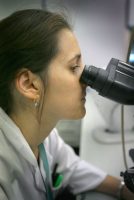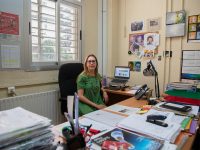Gender research from multiple disciplines
Profiles, commitments, and interrelations in an interdisciplinary group

One of the greatest difficulties in interdisciplinary work is being able to focus on a common project when labour and hierarchies do not advance in the same direction. In this paper, we describe a particular group, Genre Egalité et Mixité, and its operation. This interdisciplinary research group on gender in education, created at the University of Lyon, explores this issue along three axes: teacher training, scientific research, and the creation of a specialised library. Coming from several disciplines, its researchers have different profiles and consequently, different conceptions of feminism, making the team unique.
Keywords: gender, researcher, feminism, interdisciplinarity, France.
In the year 2000, the interdisciplinary research group Genre Egalité et Mixité (GEM) was created at the University Institute for Teacher Training (Institut Universitaire de Formation des Maîtres, IUFM) of the Claude Bernard University Lyon 1. As they explain on their website (Genre Egalité et Mixité, 2012), their mission is to «create ambitious training proposals for present and future teachers […] related to equality in education for children». In addition, their research focuses on «issues related to co-education and gender equality at school from different disciplines». On this basis, GEM tries to operate following three main axes: training for current and future teachers (primary and secondary school), scientific research, and the creation of a library specialising in gender and education. Because of its informal and educational character this is a unique speciality in France. In this text, we analyse this singularity, starting with several hypotheses on the way the group operates, and end with some thoughts about the future.
My interest on how the profiles, commitments, and interrelations of researchers from different disciplines form the structure of GEM emerged after my participation in the group in 2013. In the present analysis, which draws from observation and interviews with GEM members, I follow two main lines of thought: the first refers to plural social and commitment aspects as determinants of the researchers’ profiles and careers; the second focuses directly on GEM’s interdisciplinarity.
What is Genre Egalité et Mixité?
- An interdisciplinary research group of the Claude Bernard University Lyon 1 – Lyon (University Institute for Teacher Training, IUFM), created in the year 2000.
- It comprises seven full professors (four women and three men) and an ATER (temporary teaching and research assistant).
- It studies and researches gender at schools in various disciplines (including history, economics, cinematography, languages, philosophy, sociology, visual arts, and physical activities).
Several convergence points were identified in the careers or profiles of GEM members. All members of the group have similar backgrounds of school or university socialisation and all of them had obtained a PhD. Moreover, they had all transitioned relatively well through the formal-education stage. This education had also received financial or moral support from their families, in some cases creating a lot of pressure to reach a higher-education level.
«Genre Egalité et Mixité tries to operate following three main axes: training for current and future teachers, scientific research, and the creation of a library specialising in gender and education»
Something similar happened with the transmission of feminist commitment or activism. Two members of the group grew up in families that leaned towards the political left. The other five researchers became activists later. For Liane Henneron (2005, pp. 98–99), «family transmission» is important, «although there is no correlation between having a feminist mother and becoming an activist». However, «there is often a significant female model: the mother, grandmother, aunt, or even a teacher». In accordance with this, some of the GEM researchers recognise the impact of their mother’s influence on their decisions, in their political, academic, and group commitment, and also in them becoming part of such a group.
In any case, feminism is not a compulsory requirement in order to become a member of a gender research group. Five members consider themselves feminists, but the other two feel more comfortable describing themselves as «humanists», and reject the term «feminist» both at the personal and the professional level. Each of their individual definitions of feminism (and of feminists) can be situated between activism and extremism, varying considerably to the point of making a distinction between «male feminism» and «female feminism», considering the latter as something that is lived through one’s body and experiences. Therefore, there are differences within the group both in their feelings and in their definition of feminism and the idea is that gender perspective allows analysis to be fine-tuned. Generally, the most involved members are women who declare themselves feminists and who turn gender issues into an ever-present consideration. Thus, the level of commitment and participation seems to depend on the degree of feminist awareness. That is, the greater their feminist conscience, the more implicated they are.
The difficult balance between feminist commitment and neutral research
After thinking about their profiles, we must analyse the impact of the researchers’ political or activist participation on the objectivity of their work. Separating personal implication or activism from purely scientific activity seems difficult. For instance, what do we mean when we talk about a scientist’s feminist sentiment? Can we stay neutral when we address gender issues and consider ourselves feminists? Where does militancy end and scientific work start? Can a male scientist participate in events organised by feminist associations?

The scientific aspect of investigation is still at the heart of the research careers of GEM members, but it can put significant pressure on these professionals, especially when related to laboratory activity. / Jesús Císcar
Six out of seven GEM members were or still are activists (in NGOs, political parties, unions, etc.); two of these six exclusively practiced feminist activism. But for three of the group members, activism – especially feminist activism – represents a negative aspect that can even delegitimise scientific opinion. This is, therefore, a different – almost opposing – conception of how gender problems should be addressed from within the same research group. Three profiles can be highlighted: the feminist and activist with a strong personal and professional commitment to gender issues; the activist, feminist or otherwise, taking a neutral position in the group; and lastly, the non-activist who rejects the «feminist» label and whose commitment is almost non-existent. The next question to consider is, can gender studies exist in the absence of feminist researchers?
Succeeding in a teaching, administrative, and scientific career
Research staff must manage three types of career at once: a teaching career, an administrative career, and a scientific career. They must intertwine, manage, and integrate them all into one full-time job. All researchers have to adapt their calendar to accommodate these three activities (four, if we include their home and family duties). Their teaching career allows them to have a salary; their administrative career, which is less well known, represents a significant workload: the more responsibilities a researcher has, the more tasks they have. Finally, the scientific part is at the heart of the job. Research, especially related to laboratory activity, produces substantial pressure on these professionals. Thus, their obligation to produce publications must be taken into account as part of their combined activity because it provides them with legitimacy as researchers. In the GEM, time must be structured to also include the group’s responsibilities, activism, and scientific production. This is reflected in the profile typology established in the previous section.
Different levels of involvement depending on the disciplines
Each discipline relates more or less easily to gender and gender problems. However, in terms of activity, researchers are still far from incorporating gender perspective into all their scientific activities. Of all the GEM members, only one has committed to do so. This full professor is a feminist activist and is the most committed to the group’s activities.
But, what does gender provide to each field? Does impact vary depending on the discipline? Obviously, the systematic introduction of a gender perspective is not suitable in everyone’s fields. Thus, «the female researchers involved (and later, the male researchers) are motivated by political issues such as the women’s rights and by the search for social, economic, and political equality between sexes, partly due to the advancement of gender studies and their roots in academia, which necessarily generate professional motivations that are relevant in their careers. However, their approach is clearly scientific – they subject themselves to the same epistemological rules as the rest of social science research areas» (Gothuey et al., 2012).
Perspectives and realities of Genre Egalité et Mixité
This research group navigates three main work objectives: teaching, research, and the library or documentation centre, in addition to any current institutional and/or personal issues.
Regarding the teaching aspect, at its outset, GEM established a training programme for current and future teachers. This initiative was implemented in the first ten years of the group, but was later decimated because of the generalisation of master’s degrees and the direct connection between the IUFM and the university. Hence, this move towards master’s degrees led to the closing of the IUFM centres and a decrease in the number of activities involving GEM.
«Feminism is not a compulsory requirement in order to become a member of a gender research group»
The second axis, research, does not seem to be a priority. In terms of production, GEM only published one book, A l’école des stéréotypes (L’Harmattan, 2013). It was directed by Christine Morin-Messabel and Muriel Salle, and is the result of a collaboration between several researchers, each of whom wrote a chapter; it does not qualify exactly as an interdisciplinary work: the most accurate description would be multidisciplinary. While interdisciplinary relates to the confrontation and exchange of points of view between disciplines regarding a common research topic, multidisciplinary corresponds to the study of an item from a single discipline, analysing it from the point of view of several disciplines at the same time (Nicolescu, 2002). Other than the aforementioned book, the group organised two debates but no other activities. Thus, the group’s low activity level during its sixteen years calls this axis, and its member’s interest in participating in it, into question.
Regarding the objective of creating a «feminist» library, it led to the formation of the Aspasie Collection, which gathers documents related to the history of women and gender issues in humanities and social sciences, mainly in the field of education. This collection, located in the Lyon ESPE, represents GEM’s matrix, and constitutes a unique library in France, in terms of scale (more than 43,000 books and specialised journals in French, English, German, Spanish, Italian, and Portuguese). Unfortunately, this library lacks sufficient recognition from the university and other institutions, which makes it more difficult to obtain funds and define a clear operation strategy.
Despite the fact that the three target actions of the group have not evolved much in sixteen years, GEM has changed according to its context and members. Movements within the group, especially after its founding professor left in 2010, strongly impacted its dynamics. Today, it looks like not every member in the group understands its future the same way, and only a few of them think they will continue in the group long-term.
The effect of hierarchies
Before I check each of the objectives and commitments, I want to expound the role of hierarchies and leadership among the researchers. Thus, we could talk about:
- Discipline hierarchy: related to the level of knowledge of gender issues, their integration into the discipline and the way other members comprehend a particular discipline.
- Seniority hierarchy: members gain legitimacy and priority for their interventions depending the date they joined the group.
- Generation hierarchy: although age is not a strong determinant, the different generations of the members might explain some behaviours. This variable impacts, essentially, the definition of feminism and the way they live with it. Members who were young in the seventies tend more towards the political left and are more politicised and more radical. They push their followers into action, encouraging them to take the floor and take a stance, which is not always understood by the rest. Age also has an impact on the use of new technologies and, consequently, in the way they publicise GEM.
- Status hierarchy: not only due to the difference in university status between full professors and ATER (temporary teaching and research assistant) staff, but also regarding the way they entered the group (the founder’s support or lack thereof) and the evolution of their position within it.
- Intragroup and intergroup attitude hierarchy: this is surely the most influential aspect in the positions occupied within the group. We understand as attitude the level of commitment, but also in their teamwork and the way they represent GEM outside of the group. In fact, the higher the researcher’s involvement, the more their position within the group is reinforced, so they feel legitimised to speak for the team. At the same time, excessive activism and radical feminism can cause isolation from the group, or damage legitimacy.
Communication, harmony and ambition
Then, why belong to this group if its scientific activity is not significant and there is a lot of «negative» competition among the members?
Firstly, it is important to know that people who choose to follow a research career only have a few job opportunities at the university; being part of GEM is one of them.

Although there is no correlation between having a feminist mother and becoming an activist, having a female feminist reference or role model, like a mother, grandmother, aunt, or teacher, is frequent among GEM’s members. In the photograph, Emmeline Pankhurst (1858-1928), one of the founders of the British suffragist movement, being arrested in front of Buckingham Palace in May 1914, when she tried to present a petition to George V./ Mètode
Each of my interviews with GEM members provided evidence that they felt comfortable in the group. «Multidisciplinarity» provides a number of benefits: it is exciting and reassuring at the same time, which prevents negative competitiveness from within the same discipline. On the other hand, gender formation is also one of the leitmotifs of some of the group’s members, and one of the reasons why some want to be part of it. Beyond this, GEM provides the opportunity to be schooled in gender issues in education thanks to the other members. In some cases, it represents a professional launch pad, thanks to its participation in debates and conferences and its connection to new professionals. In addition, teaching university subjects involves an economic and curricular benefit.
The nature of relationships between members (which is strictly professional and friendly) can be seen heterogeneously from outside the group. Meetings are not too frequent (less than once a month) because all the members are busy with their triple careers, and so, organising productive sessions can prove difficult. Members confess, without hesitation, that they know each other only superficially, and they recognise that their perspectives on gender issues are also very different which leads to interpersonal conflicts among the most committed members, especially regarding the hierarchies mentioned above. It is important to emphasise that members are free to join the group and the only requirement is regular participation in some GEM meetings and activities. This makes funding and involvement in the group easier, but can obstruct social relationships, theoretical contributions, and the contribution of different values from different people.
Conclusion
We can summarise this exploratory text by pointing out that GEM’s weaknesses include the fact that there is too much freedom regarding involvement, low participation and production requirements, poor visibility of the group and its work, the weakness of the IUFM and of its members’ careers, and the resignation of the group’s founder. In addition, the lack of a common project is a threat to GEM. However, the freedom to choose how to get involved and the variety of profiles, as well as their shared values, could also represent some of the group’s strengths. Opportunities include research, joining forces with other similar entities, involving young researchers, mixing the Aspasie library with other related resources, and turning current activism and implication into increased activity. However, without a clear structure for its multidisciplinary activity, the future of the group seems complicated, especially regarding the institutional context. GEM depended on its founder for a long time, but regrettably, is now orphaned and unable to create a common project to bring together researchers with shared values and interests.
References
Genre Egalité et Mixité. (2012). L’équipe. Retrieved 24 May, 2013, from http://gem.hypotheses.org/sample-page/lequipe-3
Gothuey, J., Morales, Q., Oudin, F., Pierre, T., Sinigaglia, J., & Sinigaglia-Amadio, S. (2012). Enquêter sur le genre. Terrains et pratiques. Nancy: Presses universitaires de Nancy.
Henneron, L. (2005). Être jeune féministe aujourd’hui: Les rapports de génération dans le monde féministe contemporain. L’Homme et la Société, 158, 93–111. doi: 10.3917/lhs.158.0093
Nicolescu, B. (2002). Multi, inter et transdisciplinarité. Science et Conscience, 4.





